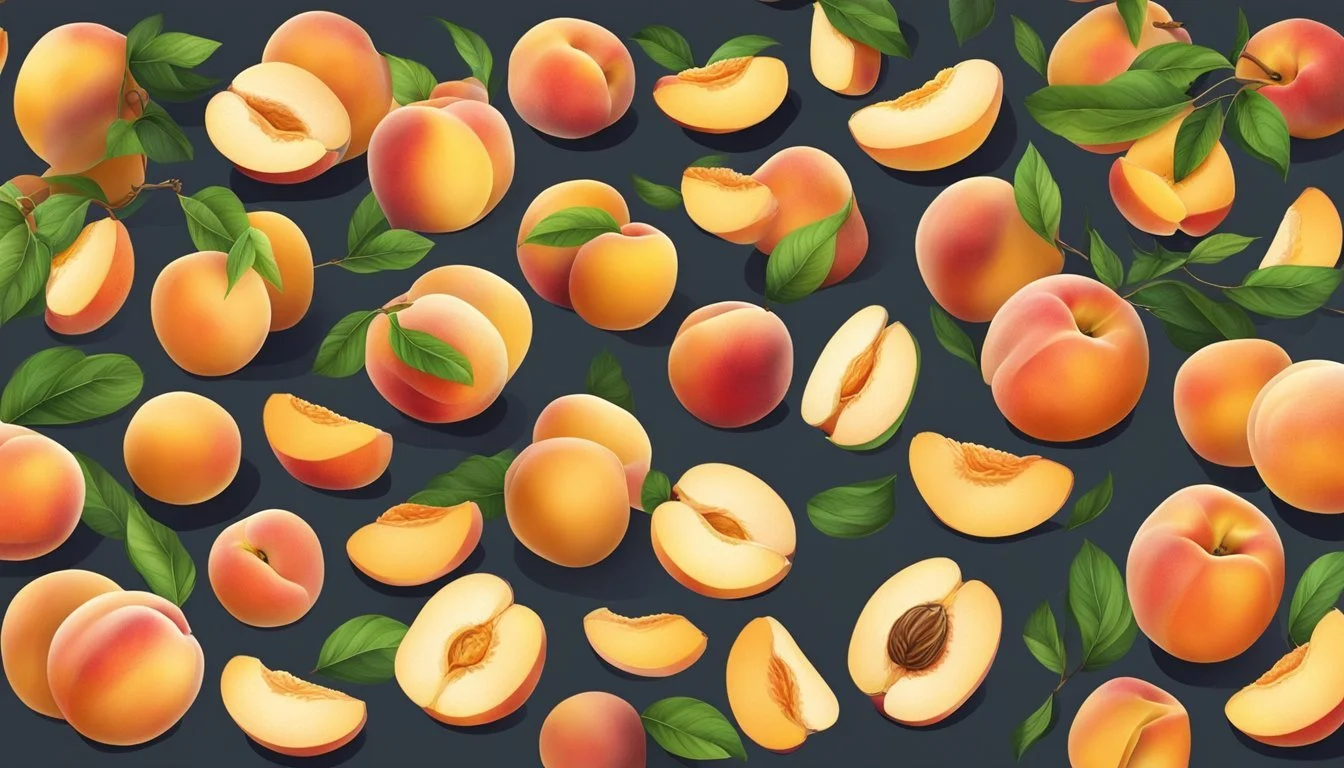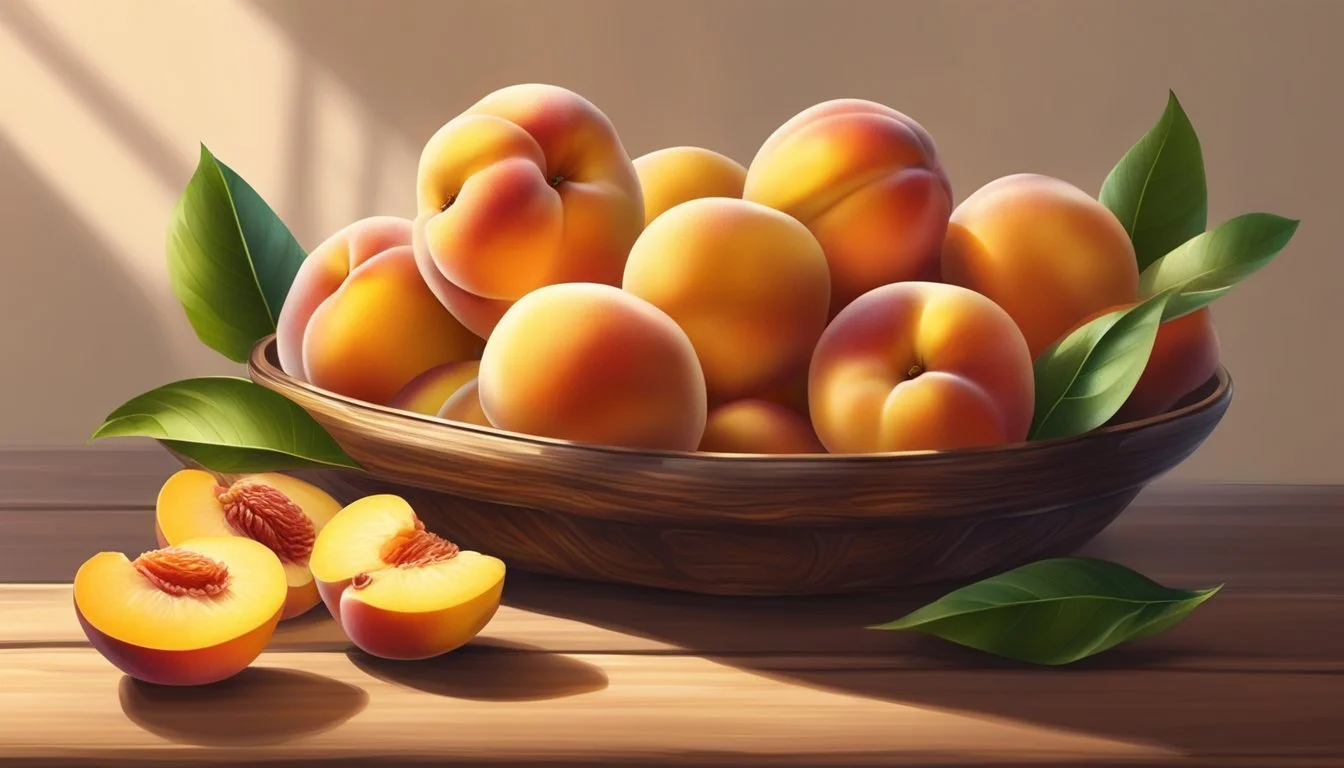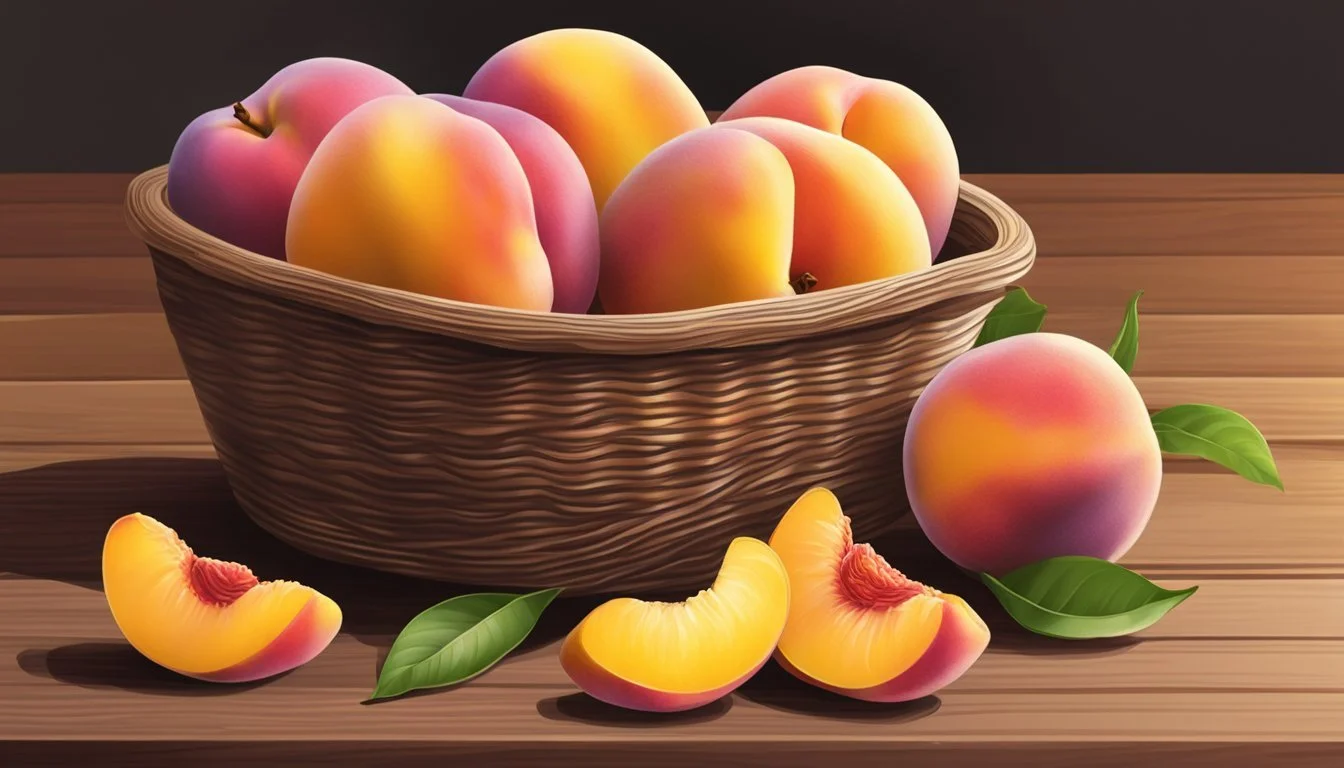How to Tell If Babcock Peaches Are Ripe
Your Ultimate Ripeness Checklist
Babcock peaches, known for their sweet taste and light-colored flesh, are a delightful summer treat many home gardeners and fruit enthusiasts look forward to. Identifying the ripeness of Babcock peaches is key to harvesting fruit that is at its peak of flavor and texture. Since these peaches have a red blush that deepens as they mature, the color of the skin, especially around the stem, serves as a good initial indicator of ripeness, with the absence of green hues signaling that the fruit may be ready to sample.
Evaluating the firmness of Babcock peaches is another crucial step in determining their ripeness. A ripe peach will yield slightly to gentle pressure, indicating that the flesh inside is soft and juicy. Moreover, the sweet, floral aroma emitted by the fruit can be a tell-tale sign of a peach that is ripe and ready for consumption. A well-timed harvest ensures that the peaches have the optimal sweetness and texture, making them ideal for eating fresh, canning, or adding to various recipes.
Key Takeaways
Babcock peaches indicate ripeness by their deep red blush and absence of green color.
Ripe Babcock peaches are slightly soft to the touch and emit a sweet fragrance.
Proper timing in harvesting ensures peak flavor and texture of the peaches.
Understanding Babcock Peaches
This section explores the background, distinctive traits, and various types of Babcock peaches, providing essential information for peach aficionados.
History and Origin
The Babcock peach (Prunus persica 'Babcock') has origins tracing back to the early 20th century in California. It's a result of breeding programs seeking to enhance the qualities of peaches for commercial and home cultivation.
Characteristics of Babcock Peaches
Babcock peaches are known for their notable red blush which graces the fruit's skin, most pronounced on the side receiving the most sunlight. The fruit itself is round and medium-sized, characterizing a freestone peach, meaning the stone easily separates from the flesh. A Babcock peach's flesh is light in color, sweet in flavor, and less acidic compared to other peach varieties. These trees thrive in full sun, amending that with placement in well-draining soil.
Varieties and Their Attributes
Variety: Babcock (Standard)
Size: Up to 25 feet tall
Description: Traditional variety, requires regular pruning.
Variety: Dwarf Babcock
Size: 5-6 feet tall
Description: Ideal for small spaces, easier to harvest.
Variety: Semi-dwarf Babcock
Size: 12-15 feet tall
Description: Offers a balance between fruit production and size.
Babcock peach trees can be found in different sizes, such as dwarf and semi-dwarf varieties, catering to gardeners with varying space constraints. Each shows resilience in the appropriate hardiness zones and maintains the hallmark sweet quality associated with Babcock peaches.
The Ripening Process
The ripening process for Babcock peaches involves stages where the fruit progresses from firm and tart to soft and sweet. Understanding these stages and environmental factors helps to determine the perfect pick time.
Stages of Ripeness
Babcock Peaches go through several stages from blossom to maturity. In spring, as the peaches set, they gradually increase in size and begin a chemical transformation. As summer approaches, these peaches transition from being small and hard with little to no aroma, to juicier and fuller fruits. The skin of ripe peaches will yield to gentle pressure and emit a sweet fragrance indicative of ripeness.
Indicators of a Ripe Babcock Peach
Color: Should have a deep yellow ground color with a red blush, without green undertones.
Firmness: When lightly squeezed, a ripe Babcock peach should feel firm but give slightly under the touch.
Aroma: A ripe peach emits a distinctly sweet and floral aroma.
Factors Affecting Ripening Pace
Factors that impact the ripening pace of a Babcock peach include:
Climate: Warmer temperatures typically speed up the ripening, while cooler weather can slow it down.
Soil: Well-draining soil with proper pH assists in the balanced growth and ripening of peaches.
Water: Regular, consistent watering promotes steady ripening, but overwatering or drought can adversely affect the process.
Optimal Growing Conditions
Proper growing conditions are vital for Babcock peach trees, which thrive in specific soil types, climate conditions, and with proper watering and nutrient management.
Soil Requirements and Preparation
Babcock peach trees require well-draining soil with a pH level between 6.0 and 7.0. Prior to planting, the soil should be amended with organic matter like compost or well-rotted manure. It's recommended to conduct a soil test and adjust the pH if necessary. Fertile, somewhat sandy soil is also preferred to ensure good root growth and development.
Climate and Sunlight
These trees are suitable for USDA zones 6-9 and demand full sun, meaning at least six hours of direct sunlight per day. A climate that provides a clear distinction between winter and summer is beneficial. During the spring, Babcock peach trees start to grow, and by summer, they can thrive in warm temperatures, provided they get ample sunlight to promote fruit ripening.
Watering and Nutrient Needs
Regular watering is essential, especially during the tree's formative years and the dry periods of summer. It's important to maintain a consistent watering schedule to prevent stress on the trees. The tree should be fertilized annually in early spring with a balanced fruit tree fertilizer. Mulch can be added around the base to retain moisture and suppress weeds. Space for trees to grow without competition for nutrients or sunlight is also crucial for robust development.
Caring for Babcock Peach Trees
Cultivating Babcock peach trees requires attentive care to ensure a healthy tree and quality fruit. Specific practices in pruning, protection from pests and diseases, and preparing for winter dormancy are imperative for the vitality of these trees.
Pruning and Maintenance
Pruning should be conducted annually to maintain the tree's shape, remove deadwood, and encourage fruit production. The best time for pruning is early spring, before the tree breaks dormancy.
Young Trees: Focus on establishing a strong framework of branches.
Mature Trees: Thin out crowded areas to allow sunlight to penetrate and air to circulate, reducing the risk of diseases.
Protecting from Pests and Diseases
Pests and diseases can compromise the health and yield of Babcock peach trees. Regular monitoring and preventive care are recommended.
Pests: Apply appropriate insecticides if infestations of common pests such as aphids or borers occur.
Diseases: Implement a fungicide schedule, especially if the area is prone to fungal infections like peach leaf curl.
Winter Care and Preparing for Dormancy
Babcock peach trees are hardy in USDA zones 6-9 and should be prepared for winter to enter dormancy successfully.
Watering: Reduce watering as the tree goes dormant to harden it off for winter.
Protection: In areas at risk of late frost, consider protective measures such as frost cloths or windbreaks.
Monitoring weather conditions is crucial in protecting trees from unexpected frost during their vulnerable blooming period.
Harvesting Babcock Peaches
When harvesting Babcock peaches, one should look for fruits that exhibit a yellow background color and a red blush, feeling slightly soft to the touch. Adequate storage is crucial to maintain the quality post-harvest, and specific techniques improve efficiency for commercial harvesting.
Best Practices for Picking
Visual Inspection: A peach that's ripe for picking will have a golden-yellow hue with a red blush, mostly on the side that has been more exposed to sunlight.
Gentle Feel: Ripe peaches should “give” slightly under gentle pressure, particularly around the stem where the fruit is less exposed to light.
Twisting Technique: When picking, twist the fruit gently; it should come off the tree with ease if it's ripe.
Storing and Preserving Your Harvest
Immediate Cooling: Post-harvest, reduce the fruit's temperature to slow down ripening. Place Babcock peaches in the refrigerator but keep them separate from other produce to avoid ethylene gas exposure.
Room Temperature: If planning to consume within a few days, keep peaches at room temperature. A ripe Babcock peach can further soften without losing quality.
Plastic Bags for Humidity: Store unripe peaches in a plastic bag with a few holes to create a humid environment, accelerating ripening.
Commercial Harvesting Techniques
Predictive Measures: Commercial growers often use predictive measures to schedule labor, ensuring that the peaches are picked at the optimal ripeness.
Mechanical Aids: Equipment such as fruit picking poles and mechanical harvesters can increase the yield and efficiency of the harvest.
Cushioned Handling: Fruit bins are usually lined with soft materials to prevent bruising, which is critical for maintaining the quality of Babcock peaches during transport.
Enjoying Babcock Peaches
Babcock peaches, with their delicate sweetness and enticing aroma, offer a versatile option for both raw and cooked culinary delights. Knowing when they are ripe and how to use them can elevate one's eating and cooking experience.
Preparation and Consumption Tips
When a Babcock peach is ripe, it should yield slightly to gentle pressure and have a deep yellow or cream color with a red blush. Here's how to prepare and consume them for optimal taste:
Wash: Always wash the peaches under cool running water before eating.
Cut: To remove the pit easily, cut along the natural seam and twist the halves.
Ripe Peaches: A ripe peach will effortlessly release its pit when cut into.
Serve: Enjoy fresh slices with a sprinkle of cinnamon or drizzle of honey to enhance the natural sweetness of the peach.
Culinary Uses
Babcock peaches are celebrated for their juicy, sweet flesh, which makes them perfect for various culinary applications:
Desserts: Use ripe Babcock peaches for sumptuous desserts like peach cobbler, peach pie, or a simple peach crumble. The peaches impart a natural sweetness, reducing the need for added sugar.
Nectar: Blend peaches with a touch of lemon juice to create a refreshing nectar, perfect for cocktails or non-alcoholic spritzers.
Grilled: Grilling peaches can heighten their sweetness and adds a smoky flavor, making them ideal for savory-sweet dishes.
Health Benefits
Babcock peaches are not only delicious but also offer multiple health benefits:
Nutritious: They are a good source of vitamins A and C and are rich in dietary fiber.
Natural Sweetness: Opting for a ripe Babcock peach to satisfy sweet cravings can be a healthier choice than reaching for processed sugary snacks.
Hydration: Their high water content helps in maintaining good hydration, especially during hot weather.
By choosing ripe, fresh Babcock peaches and enjoying them in a variety of ways, one can appreciate not only their delectable taste and versatility but also their contribution to a healthy diet.
Troubleshooting Common Issues
When Babcock peaches fail to ripen properly, it may often be attributed to certain diseases, pest infestations, or environmental stressors. This section guides the reader through addressing these issues to prevent hindrances in the ripening of their peaches.
Dealing with Disease
Babcock peach trees can be susceptible to various diseases, with peach leaf curl being a common fungal disease that causes leaves to distort and display a reddish color. Preventative measures include:
Applying Fungicides: Apply dormant fungicides containing copper or chlorothalonil in late winter or early spring before buds swell.
Pruning: Remove and destroy infected leaves to reduce fungal spread.
Diseased trees may show poor fruit development; thus, quick and effective treatment is crucial for maintaining tree health and fruit quality.
Addressing Pest Problems
Pests can significantly impact the ripening process of Babcock peaches. Here are steps to manage common pests:
Regular Inspections: Check trees for signs of pests, such as holes in the fruit or leaves, sticky substances, or visible insects.
Integrated Pest Management (IPM): Utilize IPM strategies that include biological controls like beneficial insects, and when necessary, the use of insecticides.
It's important to identify pests accurately and treat them promptly to prevent damage and crop loss.
Overcoming Environmental Stress
Environmental factors such as climate, watering, and soil conditions can also affect the ripening of Babcock peaches. Consider the following:
Climate: Ensure the tree is planted in a suitable USDA zone (6-9) and provide protection from extreme weather where feasible.
Soil: Maintain fertile, well-draining soil with a pH around 7.0, and amend with organic matter as needed.
Watering: Practice consistent watering, especially during dry spells, to prevent stress and support fruit development.
By monitoring and adjusting to the trees' environmental needs, one can mitigate stressors that may impede the ripening of peaches.
FAQs on Babcock Peaches
In this guide, the reader will discover insights about Babcock Peach varieties, the importance of rootstock in peach cultivation, and debunk common myths about these peaches.
Selecting the Best Babcock Peach Varieties
When choosing Babcock Peach varieties, gardeners should focus on two key attributes: taste and climate suitability. Babcock, renowned for its sweet flavor and creamy flesh, set the standard for white peaches. The University of California has been pivotal in the development of Babcock peaches. For different climates, there are other varieties to consider:
Redhaven: Hardy and resistant to peach leaf curl, suitable for USDA zones 5-8.
Reliance: Offers good cold hardiness, a great option for colder climates.
Harmony: A more recent introduction with larger fruit, also developed by the University of California.
Understanding Grafting and Rootstock
Grafting is a crucial process that affects the eventual quality and growth of Babcock Peaches. The choice of rootstock impacts the tree's size, disease resistance, and hardiness. Babcock peaches are often grafted onto rootstocks that offer robustness in diverse climates. Reliable rootstocks include:
Nemaguard: Known for nematode resistance, suitable for sandy soils.
Lovell: Winter hardy, a good choice for variable soil conditions.
Clarifying Myths and Misconceptions
Several myths about Babcock Peaches prevail, but facts dispel such misconceptions. It's a myth that all Babcock peaches have a uniform red blush—this depends on sunlight exposure. The belief that Babcock peaches cannot thrive in diverse climates is false; with the right rootstock and care, they are adaptable. Contrary to what some think, not all white peaches are Babcock; many new varieties exist thanks to breeding programs, especially by the University of California.








